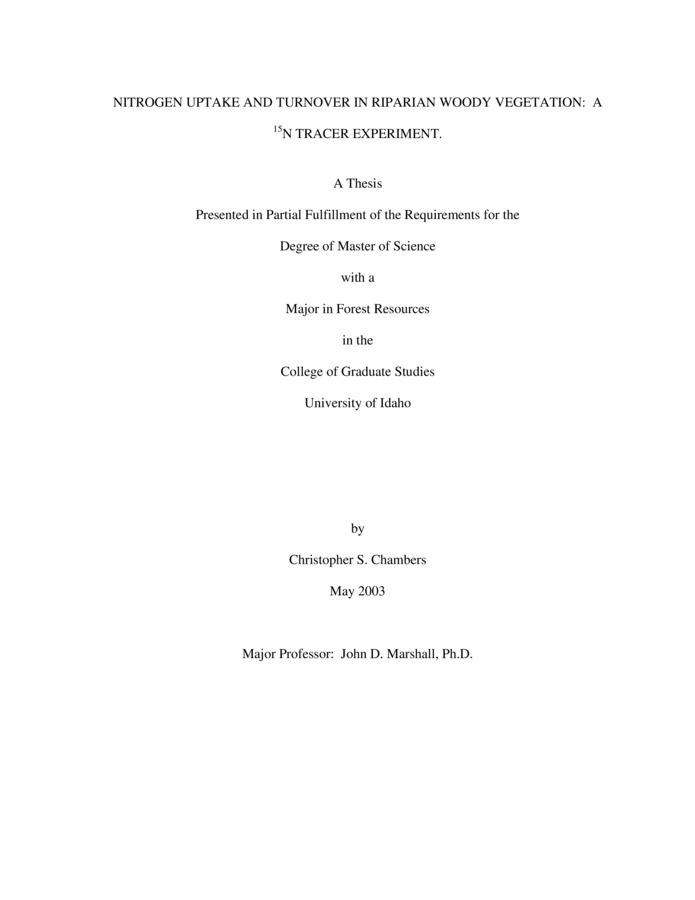PDF
Nitrogen Uptake and Turnover in Riparian Woody Vegetation: A 15N Tracer Experiment Item Info
- Title:
- Nitrogen Uptake and Turnover in Riparian Woody Vegetation: A 15N Tracer Experiment
- Creator:
- Chambers, C.S.
- Date Created (ISO Standard):
- 2003-05-01
- Description:
- The nutrient balance of streams and adjacent riparian ecosystems may have been modified by the elimination of anadromous fish runs and perhaps by forest fertilization. To better understand nitrogen dynamics within stream and riparian ecosystems, and the nitrogen transfer between them, we fertilized two streams and their adjacent riparian corridors in central Idaho. On each stream two nitrogen doses were applied to a swathe approximately 35 m wide centered on the stream. The fertilizer N was enriched in 15N to 18%. This enrichment is light relative to many previous labeling studies, yet sufficient to yield a traceable signal in riparian and stream biota. This paper reports pre-treatment differences in ?15N and the first-year N response to fertilizer within the riparian woody plant community. Future manuscripts will describe the transfer of allochthonous litter N to the stream and its subsequent processing by stream biota. Pre-treatment ?15N differed between the two creeks (p = 0.00016), possibly due to residual salmon nitrogen on one of the creeks. Pre-treatment ?15N of current-year needles was enriched compared to leaf litter, which was in turn enriched compared to needles aged 4 years and older. This leads us to conclude that fractionation due to retranslocation occurs in two phases. The first, which optimizes allocation of N in younger needle age classes, is distinctly different from the second, which conserves N prior to abscission. The ?15N difference between creeks was eliminated by the fertilization (p = 0.42). In the two dominant conifer species, Abies lasiocarpa and Picea engelmannii, most fertilizer N was found in the current-year foliage; little was found in older needles and none was detected in litter (p = 0.53). In the only N-fixing shrub species, Alnus incana, little fertilizer N was detected (mean percent N derived from fertilizer (%Ndff) 5.0 1.6% (se)). Far more fertilizer N was taken up by other deciduous shrubs (mean %Ndff = 33.9 4.5%). Fertilizer N made up 25 ( 4.2%) of the N in deciduous shrub litter. These results demonstrate the importance of pre-treatment measurements, the feasibility of light labeling with 15N, and the potential influence of riparian plant species composition on stream nutrient dynamics via allochthonous leaf litter inputs.
- Subjects:
- research streams fertilizer statistics
- Source:
- Chambers, C.S..2003. Nitrogen Uptake and Turnover in Riparian Woody Vegetation: A 15N Tracer Experiment. Masters Thesis under J.D. Marshall, May 2003
- Source Identifier:
- Nitrogen_Uptake_and_Turnover_in_Riparian_Woody_Vegetation_A15N_Tracer_Experiment_IFTNC_2003
- Type:
- Text
- Format:
- application/pdf
Source
- Preferred Citation:
- "Nitrogen Uptake and Turnover in Riparian Woody Vegetation: A 15N Tracer Experiment", Intermountain Forestry Cooperative, University of Idaho Library Digital Collections, https://www.lib.uidaho.edu/digital/iftnc/items/iftnc4850.html
Rights
- Rights:
- This document is provided by the University of Idaho Library for use by University of Idaho students, staff, and faculty. All rights to the document linked from this metadata belong to the author, rights holder, and/or provider. For more information contact The Intermountain Forestry Cooperative, https://www.uidaho.edu/cnr/ifc
- Standardized Rights:
- http://rightsstatements.org/vocab/InC-EDU/1.0/

